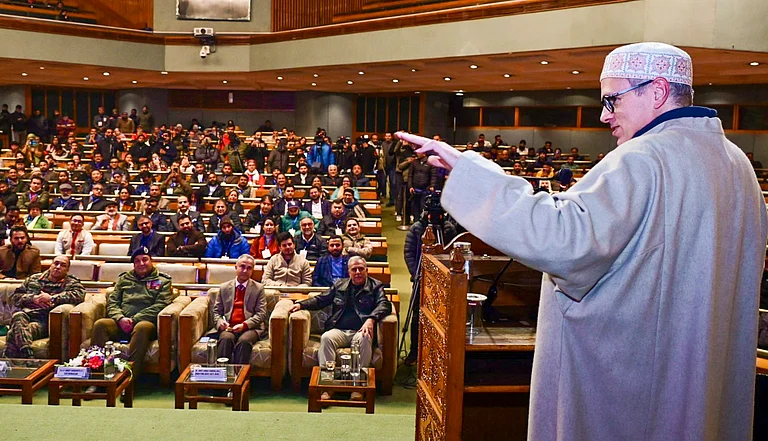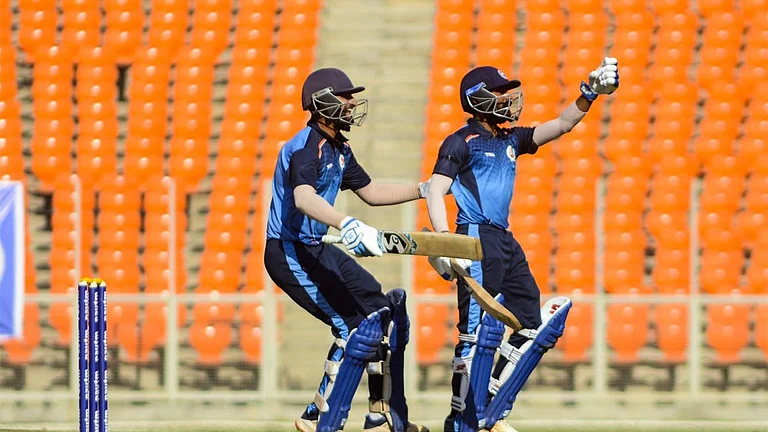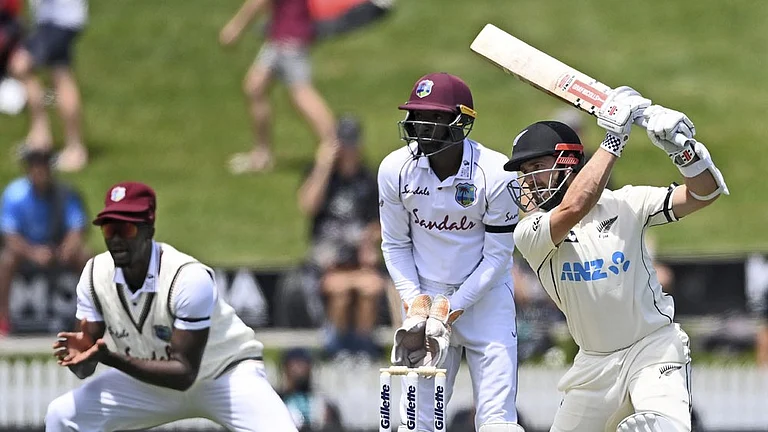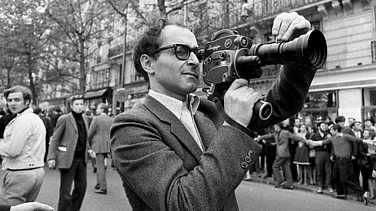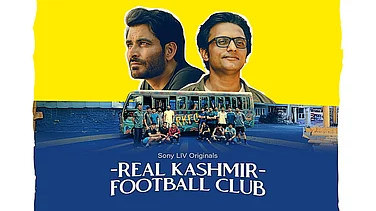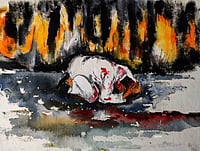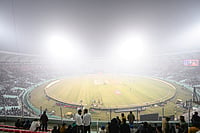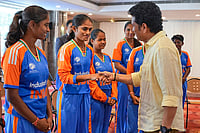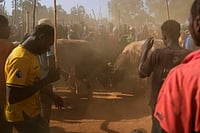In the first image, a wide-eyed young Maoist soldier, holding her rifle tightly, stares back at the camera. In the second, an older girl is seen keeping watch from behind a tree, a rifle tightly locked in her armpit. In the next few images, the beautiful, lush-green and yellow landscape transcends to dusk and twilight and young Maoists slip into the shadows. One of them is seen holding a lantern in a pitch-dark frame.
These images were captured in a politically contested region of Chhattisgarh by Ishan Tankha, a Delhi-based photojournalist. His project, ‘A Peal of Spring Thunder’, features at the ongoing Kochi-Muziris Biennale.
The images—a mix of colour and black-and-white—were clicked over a period of 7-8 years. Each image tells a story and asks pointed questions—can art nourish the scope of journalism? Can it provide more depth to reportage? Tankha feels journalism and art are both supposed to lead you to the same goal–truth. “Journalism is supposed to be telling you the truth and art is supposed to be telling you the eternal truth,” he says.
When Images Tell a Story
The landscape of Chhattisgarh stands for two varying ideas: Adivasis trying to protect their homeland versus the state and the corporates exploiting it while tapping into a rich economic resource—coal. Such contradictions give rise to conflict, and it is this conflict that Tankha has captured.
His project showcases the “everyday violence” faced by the Adivasis. The thread of the imagery is based around land, the main source of conflict in the region. Through images of the violated landscape, Tankha provides context to the inhabitants of land, issues of identity and indigeneity and human rights. He visualises the conflict in the state through a different lens and each image humanises the victims and participants of the conflict.
In the mainstream media, it is common to see images of guns and bloodied bodies as well as the overbearing representation of soldiers and surveillance tackling Naxalism. Tankha’s work sidesteps these aspects.
Yes, guns feature across the frames—in the hands of young boys and girls, strung on their lean shoulders, barrels poking through the dense vegetation of Central India. But according to Tankha that’s a myopic view. “To try and understand the everyday nature of violence does not require a gun. The guns are very small portion,” he says.
Can Art Nourish Journalism?
What Tankha has managed to achieve is significant. We live in times of an abundance of information, including its malignant variants, specifically misinformation and disinformation. In a deeply polarised and state-controlled media space, this has transformed the potential role of journalism. From a mere keeper and dispenser of credible facts, it must now also be a builder of consciousness. It should represent diversity and emotions, humanise characters and statistics and debunk misrepresentation of realities.
‘A Peal of Spring Thunder’ pushes us to investigate that question in the current sociopolitical scenario in the country. Both journalism and art complement each other; both are mediums of storytelling and means of communication. As Tankha points out, the overlap between the two is not something new. “From Goya (Spanish artist Francisco Goya) to Guernica (by Picasso), art and journalism have gone together,” he says.
Exploring All Aspects
Tankha does not present the situation from the lens of a region mired in conflict. Instead, he depicts the common concern of exploitation of land through different stages of activity in different parts of the region. For instance, South Bastar is the hotbed of guerrilla warfare and violence, and North Chhattisgarh is where one of the largest opencast mines in the world is located. These are two different kinds of violence, connected through the question of land, Tankha feels.
From the exploited land resources, the story effortlessly moves to the shadowy jungle, providing us intimate glimpses of the Maoists, their day-to-day utensils, umbrellas, photographs, small documents and assault rifles. The violence and politics are diffused through what appear to be routine activities. Then we come face-to-face with the Maoists—their faces, expressions, relaxed smiles, fatigues and red star-adorned caps.
There are tools of agriculture, pickaxes, felling axes and arrows, highlighted in grey shades. Tankha rues that these everyday instruments and agricultural tools, found across the country in different forms, are routinely listed as weapons. “A lot of the weapons that are seized are these tools. If you lived in rural India and did not own an axe it would be difficult for you to survive. It’s a basic kind of a tool,” he says.
From the jungle, his narrative moves back to the village, which according to him, is the site of all the conflicts. Talking about the depiction of everyday life in the region so weary by the long period of conflict, oppression and exploitation, Tankha says: “I am not looking at the spectacular moment. It’s not only based on the obvious drama of Naxals and guns.”
In an unbalanced and unequal situation, which has always been in favour of the extractor, what role can art play to sensitise the subject?
Re-engaging With Viewers
Tankha says that where you see certain work also affects how you see it. “When you see an image in a journalistic setting like a news story, you expect it to convey something. But when you see the same image hung in a gallery or exhibition, it can have a different impact. It can say something more, something different because the intent of the viewer as well as an exhibitor is different,” says Tankha.
The art exhibition allows a journalist like him to re-engage with the viewer, to tell them a different story or present the story in a different manner. “Journalism is a view of the world as it were. And art would be a perspective on that view maybe,” says Tankha. The space of the art exhibition also allows a journalist a different interaction with the material, the timeline and the images. To create a context for his images, Tankha borrowed from Nandini Sundar’s book and added a small poem by Jacinta Kerketta to enrich the text.
Tankha is aware of the question of appropriating voices. As a journalist, one must always remember that you are writing someone else’s story, he stresses. And sometimes there might be overlaps.
“I am not an Adivasi. Yes, it’s my voice in the images, but it’s not my personal story. It might be an overlap. When it comes to a very unequal relationship situation, you need to keep in mind the differences that you are representing,” says Tankha.
He believes in using the same techniques and rigour of reportage even for work eventually showcased at an art exhibition. “In terms of ethics of journalism, all my work is made in the same way in which I would approach a news story. I’m not creating such situations. I’m not manipulating the images. It’s not an artistic interpretation. I don’t approach it in any other way,” he says.
Restricting Art, Silencing Journalists
Not only is the nature of journalism changing, but its constraints are also becoming tighter under the present regime. The same can be said of art. Not only journalists, but even artists are also no longer immune to the risks of journalism and expression. In times of extreme repression, art has always been a means to communicate, says Tankha. But in today’s India, singers and cartoonists are also being subjected to the same oppression for having their say.
In 2019, journalist Robin Kwong said in an article that with the increase in access to information, the role of journalism was also “empathy-as-a-service” and to reach places where traditional journalism was rejected or restricted. Tankha’s intimate portrayal of the lives of the land and people in conflict-torn Chhattisgarh does just that.
(This appeared in the print edition as "Capturing CONFLICT")








